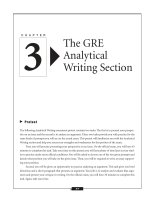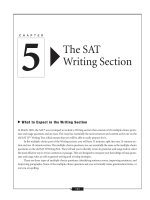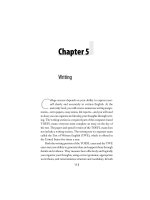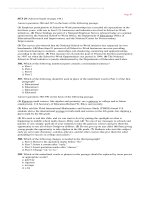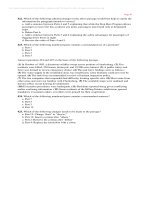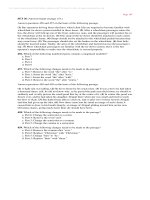Learning express Visual Writing
Bạn đang xem bản rút gọn của tài liệu. Xem và tải ngay bản đầy đủ của tài liệu tại đây (821.1 KB, 136 trang )
visual
writing
visual
writing
Anne Hanson
®
NEW YORK
Copyright © 2002 LearningExpress, LLC.
All rights reserved under International and Pan-American Copyright
Conventions. Published in the United States by LearningExpress, LLC, New
Yo r k .
Printed in the United States of America
Library of Congress Cataloging-in-Publication Data:
Hanson, Anne, 1950-
Visual writing / by Anne Hanson—1st ed.
p.cm
ISBN 1-57685-405-1
1. English language—Rhetoric. 2. Visual communications.
3. Visual perception. 4. Report writing. I. Title.
PE1408 .H3295 2002
808’.042—dc21
2001038798
9 8 7 6 5 4 3 2 1
First Edition
ISBN 1-57685-405-1
For more information or to place an order, contact LearningExpress at:
900 Broadway
Suite 604
New York, NY 10003
Or visit us at:
www.learnatest.com
contents
➧
one
Organization: It’s Everywhere! 1
➧
two
Graphic Organizers: The Writer’s Widgets 9
➧
three
Visual Writing and Cereal 19
➧
four
1-2-3 Maps: Using Visual Maps to Write Essays 41
➧
five
The Good, the Bad, and the Ugly: Winning and Losing Essays 67
➧
six
Reading and Writing Practice Challenges 85
visual
writing
take
a look around you. Organiza-
tion is everywhere. The world is
organized as continents, oceans, and
atmosphere. Forests are ordered as
trees, plants, and animals. Countries
take shape as states, cities, counties,
and towns. Even your room, whether
it’s a specific room or merely some
space earmarked as yours, has organi-
zation, too. In spite of how messy it
may be on any given day, your room is
organized into the place where you
sleep, where you store your CDs, your
clothes, and your personal stuff. If you
can think of a subject—boys, girls,
organization
1
one
Organization:
It’s Everywhere!
chapter
music, sports, you name it—you can organize it. Why? Because our brains
routinely seek out patterns of organization.
the brain’s quest to organize
saves three astronauts
O
NE OF
our brain’s prime directives,
apart from keeping us alive, is to
seek meaning out of chaos. This
instinctive desire and ability to
put things into order is one of
humanity’s greatest skills. A
scene from the movie Apollo
13 drives the point home.
A flip of a switch yields
a spark that triggers a
small explosion aboard
the Apollo 13 capsule,
aborting a trip to the
moon for three astro-
nauts. But that’s not
their only problem. They
will soon suffocate from the carbon dioxide their bodies are exhaling. Three
astronauts will perish in space unless a solution to their problem is found, fast.
It is at this point that organization saves the day.
A NASA engineer throws ordinary gadgets
and widgets onto a conference table around
which his NASA colleagues stand. The engi-
neer announces that the pile of what looks like
random pieces of junk represents all that the
Apollo 13 astronauts have at their disposal on
their spacecraft.
Will they be able to build a carbon dioxide
filter from this junk? Will they survive? This is
the dialogue in the conference room.
visual
writing
2
. . . the pile of what looks
like random pieces of junk
represents all that the Apollo
13 astronauts have at their
disposal on their spacecraft.
Will they survive?
NASA CHIEF ENGINEER:
Okay, people, listen up.The people upstairs handed us this one and we gotta come
through.We gotta find a way to make this [a box] fit into the hole for this (a
cylinder) using nothing but that, [the gadgets and widgets he’s thrown onto
the table.]
ENGINEER
1
:
Let’s get it organized.
ENGINEER
2
:
Okay, okay: let’s build a filter.
Immediately realizing they must get it organized, they work against the
clock to save the three astronauts trapped in a soon-to-be metal gas chamber.
After examining and organizing the pile of gadgets and widgets, these skilled
engineers ultimately craft a breathing apparatus—a filter, as brilliant as it is
crude. The rest of the story is literally history and one of the twentieth cen-
tury’s greatest examples of successful problem solving. How did these engi-
neers do it?
“how to construct a makeshift filter for stranded astronauts”
Do any of us believe that any NASA engineers, who accomplished this for-
midable task, studied such a topic in any engineering textbook? Of course
not! They succeeded because they brainstormed. They successfully analyzed
their:
■
subject—saving astronauts
■
topic or objective—building a filter that functions as a breathing mechanism
■
supporting details—using available gadgets and widgets to get the job
done
They successfully searched for order and pattern amid clutter and chaos and
ultimately synthesized a unique filter that served as the breathing apparatus
that saved three lives.
organization
3
1. The box begins the objective.
2. The middle—the hose—connects the beginning to the end of the
objective with supporting details that you organize with graphic
organizers.
3. The cylinder, once connected, completes the objective.
visual
writing
4
conclusion
(cylinder)
supporting details
(tubing)
1
objective
(filterbox)
3
2
did you know?
Whoever first coined the term
brainstorm
was a genius who knew what he or she was
talking about. Scientific brain imaging processes such as MRIs reveal the brain’s elec-
tronic and chemical thinking processes as different colors. They show that writers who
analyze and organize subjects and topics, using word lists and other graphic organiz-
ers before writing paragraphs, connect more neural pathways and access more
knowledge. During brain-image testing, their writing processes register as energetic
bursts of color. There really is a storm brewing in our brains.
Let the fireworks begin!
how to write an essay
for just about anyone who asks
C
ONSIDER YOURSELF
an astronaut. Not just any astronaut—but an astronaut
lost in space—much like the Apollo 13 astronauts. You will potentially suffo-
cate in the capsule chamber of high stakes—timed essay tests—that are alien to
a writing process that should allow the luxury of time. If it seems like your
chamber is getting crammed with
more and more demands to write
essays, you are not imagining
things. Today’s teachers not only
test the writing skills they teach,
but they prepare you for the chal-
lenge you are sure to face, if not
now, then soon. The state and
national standardized essay tests
that are part of every student’s
career assure state and national
officials that their education tax
dollars are producing competent young writers.
Though it may sound gloomy, there is an upside to all this testing. No
matter the origin of essay tests, their topics, or audiences, the more you write
organization
5
Visual Writing helps weak writers become bet-
ter writers and strong writers become even
stronger, because it teaches them to harness
the power of visual maps, the graphic organ-
izers that lead to effective communication.
Building stronger communication skills now
will set you apart from your peers when you
enter the job market.
and learn how to write, the better
you become at writing.
visual
writing
6
make the connection
to your writing
TEACHER:
Okay, people, listen up. The people upstairs (that would be the
state assessment office) handed us this one and we gotta come through.
You gotta find a way to make your essay’s introduction fit into the hole for
your essay’s conclusion, using nothing but the details you compile by graphically
organizing your word gadgets and widgets, which you will learn how to do in
Chapter Two.
STUDENT
1
:
Let’s get it organized!
STUDENT
2
:
Okay, okay: let’s write an essay!
➠
Try it out!
“Organization is everywhere.” The beginning of this chapter illustrated
that the world can be organized as continents, oceans, atmosphere, etc. If you
think about it, atoms are organized into molecules. Proteins are organized
into cells that are organized into body organs. People are organized into fam-
ilies that are organized into communities that are organized into towns that
are organized into counties. Counties are organized into cities that are organ-
ized into states that are organized into countries. Now that you have a clear-
er picture of the many facets of organization, apply your understanding to a
warm up exercise.
On the next page, identify organizational components for each of the fol-
lowing: your room, pizza, and zoos. Use the paper on the next page for your
response. (You will find a student example for this on page 8.)
organization
7
ORGANIZATIONAL COMPONENTS OF:
My Room, Pizza, and Zoos.
my room:
pizza:
zoos:
visual
writing
8
okay,
we’ve learned that the essay
test is not going away any time soon
and that essay tests are not a bad thing
because they help us become more
effective writers and communicators.
But since anxiety is the detour that
blocks the road to proficient writing,
how will knowing that more writing
means better writing help conquer
anxiety and writer’s block when you
face the dreaded essay test? And the
higher the test-taking stakes—passing,
promotion, graduation—the greater
the writing roadblock. Even compe-
tent writers in the throes of test anxi-
ety flounder and write essays devoid of
graphic organizers
9
two
Graphic
Organizers:
The Writer’s Widgets
chapter
organization, and consequently lose out on organizational points. If you
haven’t already learned how your essays are scored, you need a quick lesson
in rubrics.
get the point! know how
you’ll be scored
R
UBRIC IS THE
fancy word for rule.
Rubrics, then, are the rules by which
you are scored. There are many varia-
tions of rubrics, and largely the form
they take depends on the state in which you live. You will learn more about
the rules of writing in later chapters. For now, here’s a brief look at them:
■
Idea and Content
■
Organization
■
Voice
■
Word Choice
■
Sentence Fluency
■
Conventions/Mechanics
visual
writing
10
Anxiety is the detour that blocks the
road to proficient writing. And the
higher the test-taking stakes, the
greater the writing roadblock.
graphic organizers
11
The critical minutes you spend organizing your topic through visual writ-
ing ensures you an essay with organizational integrity. That organization will
help you earn most or all of the points for the Organization rubric. But the
benefits of visual writing don’t stop there. The logical flow established by
your essay’s visual map helps you see and communicate your central idea
more clearly. As a result, you will write a more focused essay that helps you
earn more Content and Idea points. Visual maps free you from “Where do I
begin?” and “How do I end?” jitters, giving you the freedom and the power
to devote more time to your word choice and your sentence structure, earn-
ing you the points earmarked for Writing Style.
(While visual maps help you with what you write, and how you mechanical-
ly write—your spelling, capitalization, punctuation, etc.—determines the num-
ber of Mechanics/Conventions points you earn.
the art of visual writing
The word essay is derived from the Latin and
French words that mean “to attempt” or
“trial.” How appropriate. An essay is very
much like a trial. And you are the defendant!
Your writing skills are the defense that deter-
mines the verdict. How will you defend your-
self? It’s up to you.
When you are taking an essay test, you are
your sole defense. You are not going to have
your teacher or this book around to help you.
So you must practice visual writing to learn the
art of organization. And it is an art.
Visual Writing is designed to help you prac-
tice. By reading each chapter and completing
each writing activity, you will learn how to
write better essays. You will also become a
better writer and communicator who knows
how to create order out of the seeming clut-
ter and chaos surrounding your ideas, opin-
ions, and knowledge.
visual
writing
12
An essay is very much like a
trial. And you are the defen-
dant! Your writing skills are
the defense that determines
the verdict. Will you be found
guilty or innocent?
the nature of the beast called the essay test
They’re out there. Essay Tests. Waiting to get
you if you’re not prepared for them. But
knowledge is power. The more you know
about essay tests, the more you’ll be ready for
them. There are basically four kinds of writing
that spawn those monstrous essay tests. Here’s
a quick review:
the simple truth about the
four kinds of writing
■
Descriptive writing tests ask you to describe something. Depending on
the essay’s topic—often called a prompt—you might be asked to describe
something or someone real, like a planet or a person. You might have to
describe something or someone imaginary, a UFO, or an extraterrestrial.
The focus of descriptive writing: Effective usage of imagery and
sensory details.
■
Narrative writing tests ask you to tell a story. You might be asked to
write the story behind a personal experience, or construct a fictional
story using your own imagination with guidance from the prompt.
The focus of narrative writing: Effective storytelling with atten-
tion to characterization, setting, and plot development.
■
Expository writing tests ask you to inform your reader about a specif-
ic topic. Expository essays challenge you to use knowledge you have ac-
quired—via school or life lessons—or there could be certain information
included in the test question that you must use as support in your essay.
The focus of expository writing: Skillful presentation of infor-
mation on a specific subject or topic.
■
Persuasive writing tests ask you to persuade your reader to agree with
your opinion on a particular subject or topic. Formats required vary
from paragraphs to letters, both informal and formal.
The focus of persuasive writing: Clear, effective argument using
logic and reasoning.
graphic organizers
13
essay tests
writing on demand and braintalks
You might be thinking right about now that writing an essay, no matter what
kind, isn’t going to be difficult, and you’ll be set as long as you read this book
and learn how to map your ideas. Unfortunately it’s not that simple, because
there’s one more problem: TIME!
Essay tests, especially those high-stakes essay tests that hold everything from
passing to promotion in the balance, require that you complete the test in a spe-
cific amount of time. That’s why you need to
braintalk. Journals and diaries are good examples
of braintalks. A braintalk is simply a talk with your
brain on paper. It’s like a freewrite directly
addressed to one audience: your brain. During an
essay test, write a short, fast note to your brain.
Explain to it what you have to do and how much
time you have. In your braintalk, order your brain
to do these things: choose the most effective kind
of visual map, construct a visual map that lays out
relevant details, and be ready to interpret it so that you can write a great essay.
You might be thinking right about now: “Hey wait a minute! My brain
knows what I have to do. It’s what helped me read the essay prompt in the
first place.” True, but brain research supports the wisdom behind using a
minute or two to dialogue with yourself, on paper, rather than just thinking.
writing: a whole brain experience
Holding a pen or pencil to paper to write a virtual letter to yourself connects
your kinesthetic learning style to the intrapersonal and visual learning styles you’ve
already set in motion by reading and thinking about the essay prompt. The
more learning styles* you connect, the more neural pathways you activate in
your brain. You literally electrify your brain to wake up and get to work!
*The brain has many learning styles. To learn more about your brain and how it works, surf
the web—keyword: brain. You’ll be amazed. Or, go to brain connections at www.susd.org/
schools/middle/Ingleside/Brain%20Connection%20WebPage/index.htm
visual
writing
14
When connecting learning
styles, you connect neural
pathways that activate in
your brain. You literally elec-
trify your brain to wake up
and get to work!
Without going into too much detail, the brain has two hemispheres, left
and right. While organizing is a predominantly left-brain skill, seeing the
big picture behind anything is the job of the right hemisphere. For exam-
ple, the right side of your brain sees the forest, while the left identifies its
components: the trees, leaves, squirrels, acorns, etc. Trust me: A braintalk
is the right brain’s written request to the left brain for organizational help.
Sometimes a few sentences are all you need to ignite the left-brain sparks
that help create detailed graphic maps. (See next page for a visual map that
explains the concept of the perceptual thinking habits of left and right
brains.)
So, are you brain-ready? If you are, Visual Writing will show you how to
organize your ideas, opinions, and facts so that you can successfully tackle any
of today’s essays, not to mention tomorrow’s far more challenging real life
essays—resumes, applications, employee memos, and reports. You get the
idea. So let’s get started!
part of the brain really can’t see the forest for the trees . . .
The right hemisphere of the brain identifies whole pictures. In the case of a
forest, it sees the entire forest.
The left hemisphere of the brain identifies the specific components that
make up a whole. In the case of a forest: the trees, leaves, squirrels, acorns,
etc. The left brain really can’t see the forest for the trees!
visual writing challenge #1
create a word web that identifies your room’s contents
Think about your room or the space you call home. The examples on the
next page will help you get started. Notice how Example 2 is similar to
Example 1. Example 2, however, has boxes around groups of words in which
titles or headings have been added, “Entertainment Center” and “Magazine
Stand.” The example illustrates how your left and right brain work together:
as the left brainstorms specific details like magazines and books, your right
brain helps you define their broader conceptual headings, i.e., “Magazine
Stand.”
graphic organizers
15
visual writing challenge #1: my room
example 1
example 2
visual
writing
16
VISUAL WRITING CHALLENGE #1: WORD WEB ON MY ROOM
graphic organizers
17
A word web is the perfect graphic organizer for an essay that asks you to describe
something. After brainstorming all the details you can, search for patterns or groupings
to help you organize further so that you can write a sequentially logical essay.


